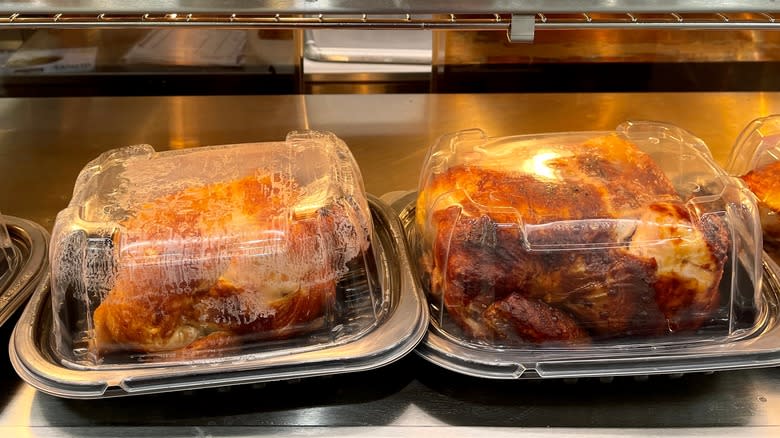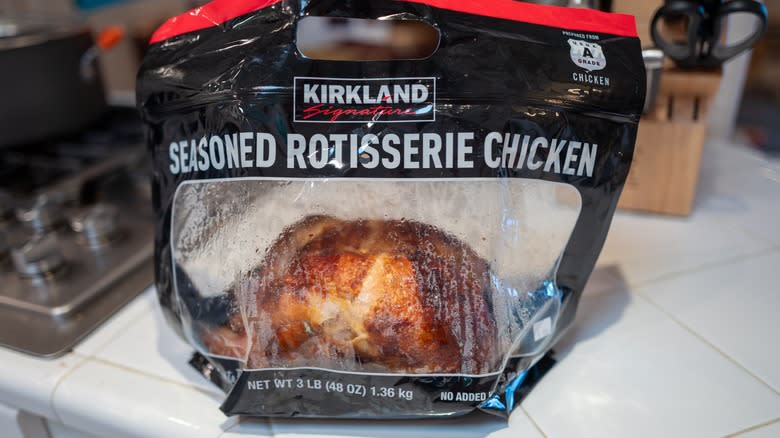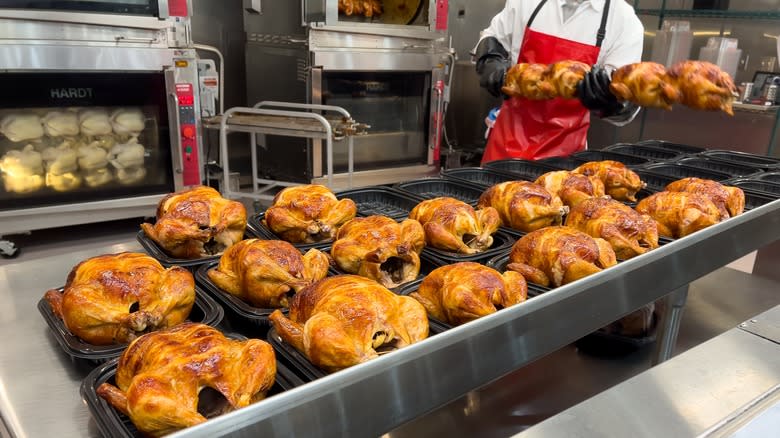Here's What Happens To Costco's Rotisserie Chickens After Their 2-Hour Shelf Life

Whether they're selling ultra-briskly to a store full of customers, or disappearing after the limit of their two-hour shelf life, Costco rotisserie chickens seem to be constantly in flight. To get the best deals at Costco, there's a lot to master, including how to read the price tags and seeking out treasures in the frozen food aisle. But there's one surefire money-saving gambit at the warehouse-style membership chain, and it's those hot, fresh-out-of-the-oven rotisserie chickens that just taste so good.
Seemingly impossibly low-priced at just $4.99 (not including sales tax where applicable), Costco sells about 100 million birds each year, per CNBC. Even though the company operates a vertically integrated system to supply itself with its versatile, fully-cooked poultry, it's still a numbers game for Costco. According to The Hustle, not only are the chickens a loss leader (meaning they may not turn a profit on an item-by-item basis), but they've got a ridiculously short shelf life. Costco puts out batches of rotisserie chickens throughout the day, and if they don't sell within a two-hour period, employees will take them off of the sales floor. What happens next is a system of innovative and sustainable actions that Costco uses to make the most out of its unsold two-hour-old chickens.
Read more: The 12 Best Grocery Store Rotisserie Chickens, Ranked
Costco Collects And Saves Rotisserie Chickens Unsold After Two Hours

Not even the typical Costco, with its high customer count and high average tickets, can sell each and every one of all of the hundreds of rotisserie chickens prepared in its kitchen each day. Each chicken's packaging is subtly marked to note what time it came out of the oven, into a plastic container, and then onto a shelf so that employees know when to remove it. And that's right around two hours after it goes out. No matter how many remain unsold, Costco doesn't typically throw away any of its whole, fully-cooked, perfectly edible but not-quite-ideal chickens.
Publicly committed to cutting down on food waste chain-wide, Costco uses unwanted but still edible materials as a starting point for other ready-to-eat food items. "These products change from time to time and by location, as we seek creative new ideas," Costco attested in the 2023 report "Minimizing Waste." Rotisserie chickens especially inform many new dishes, a prominent ingredient in pre-made Costco deli products in stores found in the U.S. and abroad.
Rotisserie Chicken Is An Important Ingredient In Costco's Deli Dinners

Not only does salvaging the many pounds of usable chicken from an unsold bird help Costco not throw away food (and thus lose money), but the process helps it earn revenue. Most any sprawling Costco deli section -- right near the hot shelves where fresh rotisserie chickens are sold -- features an ample volume of chicken-based items and quick-heat meals sold in massive quantities. Costco members might regularly come across large plastic containers of mixed white and dark meat chicken, removed from a carcass of a former rotisserie chicken and then finely shredded for use in any number of recipes.
That same shredded meat will be found along with noodles, vegetables, and broth in jugs full of pre-made chicken noodle soup. Rotisserie chicken leftovers also go into Costco's chicken enchiladas and its ready-to-bake chicken pot pies, among other family-size offerings, for which Costco can charge a premium. All that food is safely and consistently refrigerated until it's sold (or it meets more shelf-life expiration dates), extending the life of the protein that Costco went to great lengths to produce. And this little product line is all based on chicken pulled off the shelf because it was two hours old.
Read the original article on The Daily Meal.


